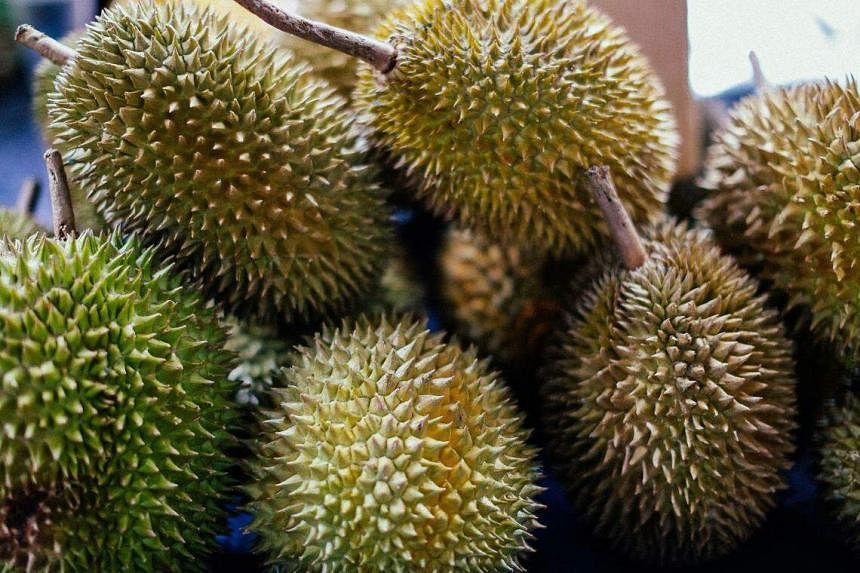Will it taste better?
Will it be cheaper?
Will the ah tiongs make fake liu lians like they make fake rice?
Will it have embedded chip to record and transmit information back to HQ in Hainan island?
First harvest of Chinese durians to hit the market in June
Durians have been popular among Chinese consumers in recent years. PHOTO: PEXELS
Amanda Lee and
Wallace Woon
Mar 21, 2023
Known as China’s Hawaii, the Hainan Island is famous for its tropical beaches and its scenic golf courses.
But the island, located at the southernmost point of China, is set to make its name for another product – durians.
After four years of growing durian trees on the island, which is about 47 times the size of Singapore, some 2,450 tonnes of Hainan durians are set to make its debut in the market in June, according to local news reports.
The reports did not state if the durians will be sold domestically or internationally.
Quoting an unnamed officer from the Department of Agriculture and Rural Affairs of Hainan Province, reports said that Sanya city stepped into durian cultivation in 2019.
Durians can be grown on Hainan Island due to its climate, which is almost tropical with mild winters.
Agricultural specialists from South-east Asia reportedly helped to plant the durian crop, while Chinese specialists improved the imported seeds to better suit local weather conditions.
The city is trying to turn durian production into one of its key industries.
Currently, about 670ha – or the size of about 938 football fields – of land in Sanya are devoted to the crop, with 20 per cent to 30 per cent of the trees beginning to bear fruit.
The South China Morning Post (SCMP) reported that Sanya is aiming to build a durian industrial estate spanning 3,333ha within the next three to five years.
This is anticipated to generate an output value of 5 billion yuan (S$973 million) by 2028.
Durians have been popular among Chinese consumers in recent years.
This is particularly so among young people, according to data released by Jingdong Supermarket in November 2022. Over 60 per cent of durians in the country are bought by consumers aged between 16 and 35.
China Daily reported that since 2019, the country has imported more fresh durians than cherries in quantity, cementing its place as the king of imported fruit.
The Covid-19 pandemic, which affected global supply chain for an extended time in 2020, also did not lessen Chinese consumers’ love for the fruit.
In 2017, China imported 224,400 tonnes of durian. In 2021, this increased to 821,500 tonnes , according to the General Administration of Customs in China.
In 2022, durian is China’s No.1 imported fruit, reaching US$4.03 billion (S$5.4 billion) and a total import volume of 825,000 tonnes, according to data from the China Chamber of Commerce for Import and Export of Foodstuffs, Native Produce and Animal By-Products (CFNA).
According to the CFNA, Thailand represented 96 per cent of China’s durian imports by value and 95 per cent of the total import volume in the past year. Other sources included the Philippines, Vietnam and Malaysia.
Thailand is the world’s largest durian grower. In 2021, the country exported about 100 billion baht (S$3.9 billion) worth of the fruit to countries including China and South Korea.
On Sunday, The Bangkok Post reported that China-grown durian should not have any serious impact on Thai durian exports, given limited supplies in China.
Mr Sumit Khiawkhajee, secretary-general of the eastern chapter of the Federation of Thai SME was quoted in the report saying that the cultivation of durian in other countries, including Vietnam, Cambodia and China, had provided more competition.
However, Thai durian remains in international demand, he said, adding that there is still high demand for the fruit from inland Chinese cities.
Chinese people are willing to pay for Thai durian’s “pleasant taste” and viewed Thai durian as a premium product, he added.
Analysts told SCMP that Chinese-grown durian could reduce domestic prices and boost international agricultural cooperation.
Most tropical fruit in China are still imported and their taste is difficult to replicate, said Mr Weng Ming, a researcher at the Institute of Rural Development at the Chinese Academy of Social Sciences.
“Figs, for example, are mainly produced in the Middle East and North Africa, and the taste of figs from Shandong, China, is nowhere near the taste of imports,” he said.
Mr Weng added that China’s foray into durian growing “definitely won’t affect the durian industry in South-east Asia”.
Singapore gets 89 per cent of its durians from Malaysia, with the rest coming from Thailand and the Philippines, according to the Singapore Food Agency in 2020.
Prices of the fruit in Singapore are determined by various factors such as seasonal changes.
For example, The Star reported on Sunday that Malaysia durians
may be more costly in the next harvest season between May and July due to the floods in Johor which affected many orchards.
Malaysia Fruit Farmers Association vice-president Francis Hong Sun Ho said: “We expect to see a drop of more than 50 per cent in durian production from Johor this year, and this will surely affect the price.”

